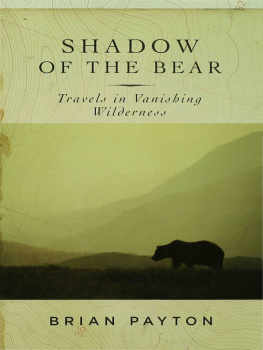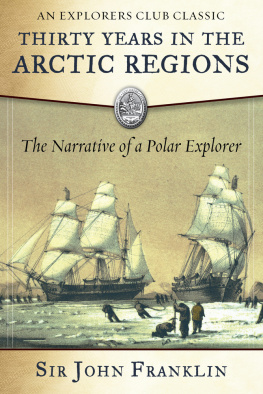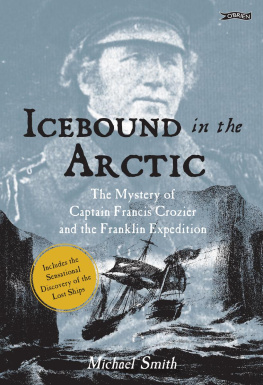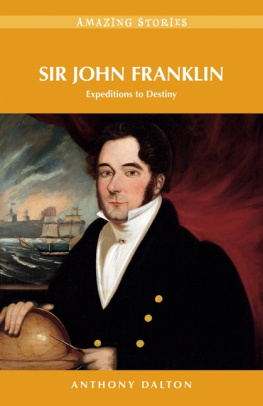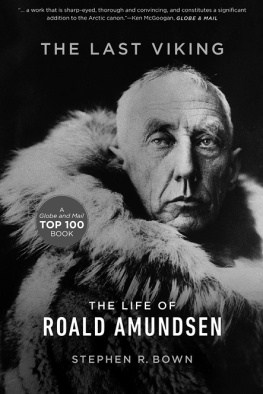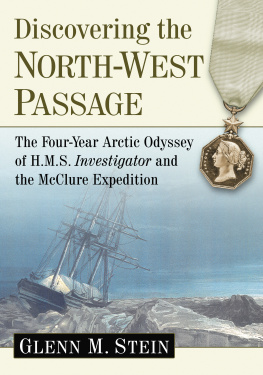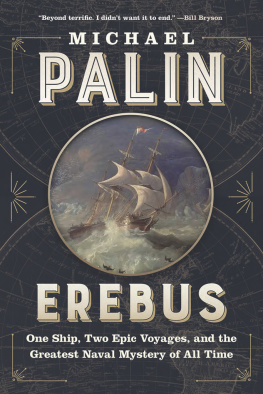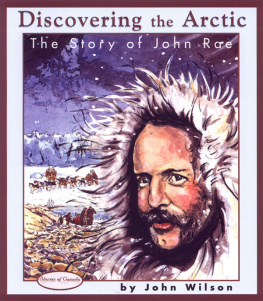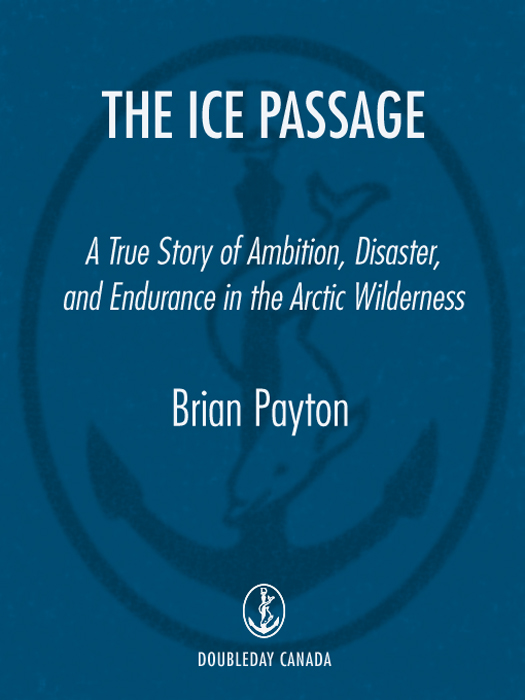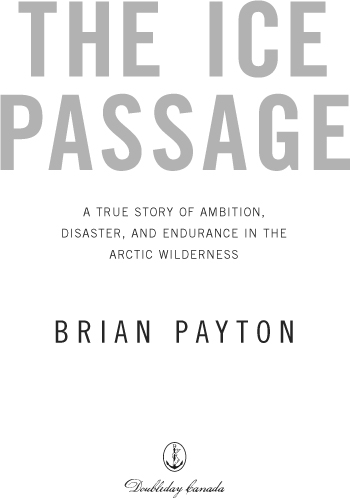Table of Contents
25.
ARCTIC NORTH AMERICA (Coastline Known to European Mariners in January 1850)
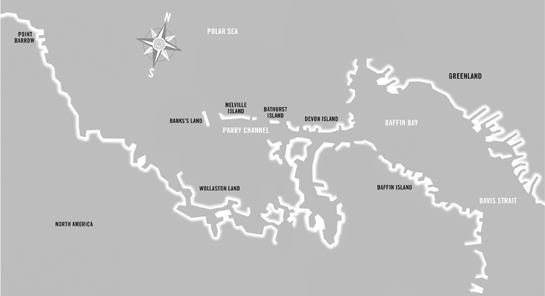
ARCTIC NORTH AMERICA (Journey of HMS Investigator)
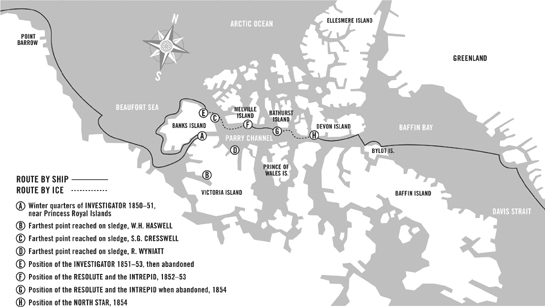
Prologue
RECKONING
ON SUNDAY, SEPTEMBER 16, 2007 , a small craft sailed effortlessly around the Earth fourteen times, just as it had every day for nearly a dozen years. The payload module of RADARSAT-1 resembled an upright refrigerator swaddled in gold leaf. With its long, wing-like solar arrays stretched out on either side, it was a cubists albatross on a perpetual glide above the sea. From five hundred miles above, it cast a cold and unblinking eye on great swaths of land, water, and ice. It surveyed the naked Earth through changing veils of cloud, snow, smoke, and smog. On this day, the images it captured and beamed back showed that a rift had opened at the top of the world.
The polar ice capa shifting, frozen mass the size of Europehad been in steady retreat since the 1980s. In 2005, scientists were astounded by satellite images revealing the greatest single-year reduction in sea ice ever recorded. When the pictures arrived on September 16, 2007, they showed something much more ominous. That day turned out to be the years apparent Arctic sea ice minimum, the point at which summer melt comes to an end and autumn accumulation begins. It would also be, by far, the lowest extent of sea ice ever recorded. One million square miles of icean area nearly four times the size of Texashad gone missing. For perhaps the first time in a million years, a large expanse of the Arctic Ocean was exposed, signalling both the realization of a long-held dream and a warning of potential catastrophe.
Polar ice scientists, oceanographers, and climatologists found themselves scrambling for new adjectives to render their sense of alarm and dread. However, having relayed dire warnings about polar ice retreat two years before, the media were slower in reporting this more profound event and its implications. This time around, leading the news in many parts of the world was the fact that the Northwest Passagesea lane of myth and legendwas not only open for the first time, it was essentially ice-free.
We have wanted it badly and for a very long time, this lazy route between Europe and the Orient. Once found, it was to link the great markets and resources of the world, ushering in a new era of unprecedented wealth and power for those who could manage it. It was, after all, what inspired Christopher Columbus to sail boldly west to reach the East. Despite mounting contradictory evidence, the great navigator took to his grave the staunch belief that he had indeed reached the Indies and Cathaythat he had succeeded in making the dream come true.
Belief in this passage persisted as the map of the New World was gradually sketched in. The faith adapted, transformed, and evolved into three denominations: a Northwest Passage through North America, a Northeast Passage along the top of Eurasia, andthat ultimate prizean Open Polar Sea. This least known and most improbable idea was tantalizing in the extreme. Proponents claimed that behind a seemingly impenetrable ring of ice lay a large, warm, open body of water at the pole.
Speculation about a temperate polar region stretches back to the earliest conception of a spherical Earth. While most ancient Greeks believed that the poles were frozen wastes, some claimed that beyond Thrace, where the god Boreas (the North Wind) dwelled, was Hyperboreaa land of leisure where the sun always shone. In early modern times, the belief in a navigable Polar Sea was first suggested in print in 1527 by Robert Thorne, agent of a prosperous Bristol-based trading company, whose father had been a crewmember of John Cabots original 1496 voyage to Iceland. Thorne proposed the notion of an Open Polar Sea in a letter to Henry VIII. When the king showed little interest, Thorne published his hypothesis in a pamphlet entitled Thornes Plan. In it, he declared: there is no doubt, but sailing Northward and passing the Pole, descending to the Equinoctial line, we shall arrive at the Islands of Cathay, and it should be a much shorter way than any other. Explorers Willem Barents and Henry Hudson shared the belief. In the seventeenth century, Englands Royal Society debated Dutch reports that they had actually discovered such a passage across the pole. The notion of an Open Polar Sea was eventually set aside, as neither scientific nor practical evidence could be found.
Then, in 1817, reports of an extraordinary breakup of sea ice occurred on the coast of Greenland and revived the faith. It would gain further credence as the search for the Northwest Passage gained momentum. The great Arctic explorer Sir William Edward Parry, a believer, continued the search for a way through the barrier of ice and into the open water. In 1845, Parry sent Sir John Franklin to continue the hunt for a Northwest Passage as well as for open water leading to the pole. Franklins quest famously resulted in the disappearance of the two ships under his command, HMS Erebus and HMS Terror, as well as all 128 men in his expedition. As the years passed without word from Franklin, some suggested that he and his men could still be alive among an unknown race of people on the palm-fringed shores of the Open Polar Sea.
In an unprecedented international rescue effort, twenty-three ships were dispatched between 1848 and 1853 to find the lost explorer and solve, once and for all, the persistent mystery of the Northwest Passage. Although the tools, technology, and vessels employed were the finest available, the mariners charts showed enormous gaps in knowledge. The price of filling those holes would ultimately be measured in human lives. One crew sent to the Arctic during that great search would succeed in being the first to circumnavigate the Americas and return with the answer to that larger, older question. They would find and cross the last link of the Northwest Passage and complete what was considered the greatest maritime achievement of the age.
On January 20, 1850, HMS Investigator set sail from Plymouth with a favourable wind. Her officers and crew would ultimately face starvation, madness, and death in an unknown wilderness. They would bring back the first sustained observations of the climate, flora, and fauna of the western Arctic Archipelago, and be among the first Europeans to contact the local native people. Theirs was a four-year battle with the polar iceengine of oceanic currents, reflector of solar energy, regulator of the global atmosphere, habitat of the supremely adapted, testing ground of ambition and endurance, fortress of myths and dreams.
I must admit that this is not the story I set out to find. Like so many who have gone to explore or navigate some portion of the Arctic, I reached a point in my journey where I was obliged to change course. After a period of indecision, I abandoned all preconceptions and embarked in an unforeseen direction. I am very glad I did.


